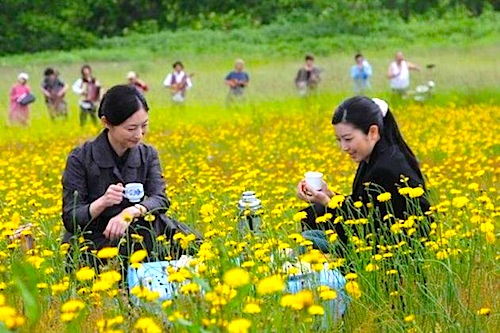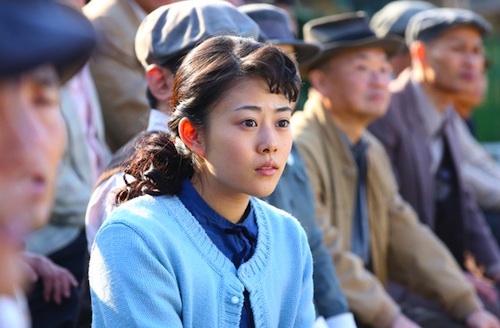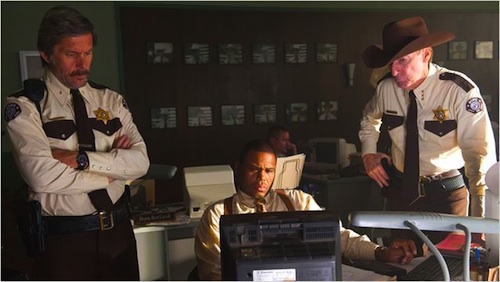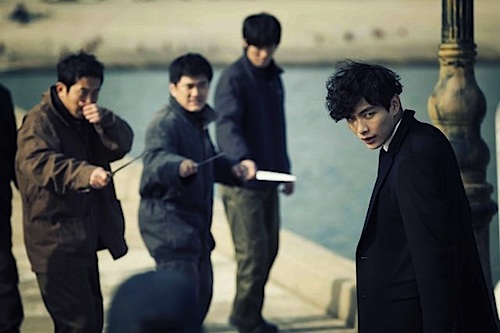By Joe Bendel. In early September of 1945, most of Japan thought WWII was over, but not the residents of Karafuto (now Sakhalin) Island. They were still being razed and rounded-up by the marauding Soviets. That grim historical episode played a pivotal role in the history of the Suzuki family, in ways that are only now coming to light as they gather to mourn their patriarch in Nobuhiko Ôbayashi’s Seven Weeks, which screens during Japan Cuts 2015, the Festival of New Japanese Film in New York.
At ninety-two, Mitsuo Suzuki had quite a run, but it was not always a bed of roses. Due to random post-war tragedies, the doctor-turned-local-cultural-curator survived all of his sons and daughters-in-law. He had already lost his great love during the war, through circumstances that will be revealed over time. Still, he was never lonely, having personally raised his granddaughter Kanna and third grandson Akito, with the help of his nurse, Nobuko Shimizu, whose position in the household is ambiguous but significant.
Following his death, Kanna plans the traditional seven seventh day mourning rituals, along with Suzuki’s grandsons, his sister, and his great-granddaughter Kasane, but most of the work falls on her, until Shimizu mysteriously reappears. As they pay their respects, Suzuki’s spirit offers his own running commentary, seeming to inspire flashback reveries for most of his family.
Eventually, we learn exactly how the Suzuki family reached this point in time. Yet, Seven Weeks is more than just a family saga. Ôbayashi essentially turns the Japanese national psyche inside out, making connections between the Suzukis and the Soviet occupation of Karafuto (still going on, by the way), the fall of Imperial militarism, the bust and boom of the Japanese coal industry, and the Fukushima nuclear crisis.

If you only know Ôbayashi as the mad man responsible for the utterly insane cult classic House (Hausu), you don’t know the half of him, at least not anymore. Seven Weeks is an achingly sensitive work, yet there is a symbol stylistic boldness—a willingness to go for broke—shared by the two films. Ôbayashi restlessly segues between point-of-views, throwing realism to the wind with frequent fourth wall breaches, some stunning super-imposed visuals, a Greek chorus of strolling troubadours, and a substantial element of magical realism hiding in plain sight. Yet, he maintains a visceral connection to the Suzuki family’s raw and formerly repressed emotions. If you cried during Departures, Ôbayashi will probably get you misty-eyed too, even though he breaks every possible rule of tear-jerking melodrama, several times over. To that end, he gets a critical assist from Kôsuke Yamashita’s unclassifiably mournful theme.
Seven Weeks is generous with its large ensemble, giving just about every character of standing an opportunity for a grand, telling moment. However, the film is anchored by the trio of Toru Shinagawa, Saki Terashima, and Takako Tokiwa, as Old Man Suzuki, Kanna, and Shimizu, respectively. You will be hard-pressed to find three performances of such mature reserve and expressive power in another film. However, Hirona Yamazaki might just provide the film’s X-factor as young Kasane, who is shallow and self-centered, but also so much fun she energizes and elevates all her scenes.
Frankly, it is exhilarating to see a film that is so big in its conception and so intimate in its execution. Somehow, Ôbayashi reconciles the micro with the macro, offering a very personal and idiosyncratic perspective on some profoundly turbulent national history. When it is all said and done, you really feel like you understand this family and share its grief. Very highly recommended, Seven Weeks is the absolutely-can’t-miss film at this year’s Japan Cuts. It screens this Saturday (7/11) at the Japan Society.
LFM GRADE: A+
Posted on July 10th, 2015 at 4:48pm.





